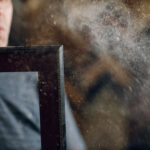Whole-Home vs. Room Air Cleaners: What Actually Improves Your Indoor Air?
Shot on a blue-sky day out by the river and sorghum fields… which is exactly why we need to talk about the air inside our homes.
Most of us have heard the stat: indoor air can be 2–5× more polluted than outdoor air, and sometimes much higher. That sounds wild when you’re breathing crisp mountain air—but it’s true, and it’s why the air you breathe for 90% of your life (indoors) deserves real attention. EPA+1
Before we dig in, a quick story. Early in my career, the Sharper Image “Ionic Breeze” was everywhere—until independent testing and lawsuits exposed that it didn’t live up to its claims. That moment kicked off a lot of confusion about room air cleaners, what they can (and can’t) do, and why many people don’t get the results they hoped for. Public Justice+1
TL;DR
-
Room purifiers move a small amount of air quietly; helpful for a single area, but easy to overestimate.
-
Whole-home solutions leverage your HVAC fan (10–20× the airflow of a room unit) and treat every room.
-
Best results come from layered IAQ: high-surface-area filtration (MERV 11–16), active air treatment (e.g., REME HALO), balanced ventilation (HRV/ERV), and humidity control (≈40–60% RH). CDC Stacks+4EPA+4RGF Environmental Group+4
-
Add radon awareness in Utah: ventilation and/or mitigation matter. vim-1.itrcweb.org
Why Room Air Cleaners Rarely Match Their Hype
Most portable purifiers are designed to sit near you and run quietly. Quiet means low airflow (often under a few hundred CFM), which limits how much room air they actually cycle and clean. That’s okay for a bedroom or desk zone, but it’s not a whole-home strategy.
By contrast, your furnace/air handler routinely moves orders of magnitude more air through ducts every hour. When you put the right cleaning technology on the system you already own, you clean all the air that’s being circulated—without living next to a humming box.
Key takeaway: Use room units tactically; use your HVAC for house-wide results. EPA’s guidance backs this up: portable cleaners are for single rooms, while HVAC filtration addresses the whole home. EPA
The Four Big Indoor Air Challenges (and What Works)
1) Particulates (dust, dander, smoke, pollen)
These are the visible troublemakers that irritate sinuses and lungs and contribute to fatigue. The fix is filtration plus airflow:
-
Skip “bird-catcher” filters. Cheap 1-inch pads rarely capture fine particles and can allow dirt to coat your blower and coil—leading to costly cleanings later.
-
Aim for 4-inch media (or deeper) with real surface area. These keep systems clean, last longer (often 6–12 months), and capture down to 0.3 µm with the right MERV rating—exactly where a lot of respirable particles live.
-
Let your system move air. A great filter without airflow is like a net no one swims through.
EPA’s consumer guide calls this out plainly: upgrading HVAC filtration can meaningfully reduce particulate pollution, and no filter removes everything—so pair filtration with source control and ventilation. EPA+1
Pro tip for Utah homes: Our dusty summers can clog 1-inch pleats in weeks. A deeper media filter keeps resistance lower for longer, so your fan doesn’t struggle and your cooling performance stays crisp.
2) Biologicals (bacteria, viruses, mold spores)
Filters catch some spores and bio-laden particles, but many microbes are tiny or hitchhike on particles you don’t catch. You have two families of solutions:
-
Passive UV (lamp in the duct or at the coil): helps keep coils clean and inactivates organisms as air passes the lamp, but has limited reach and does nothing to sanitize surfaces or distant rooms.
-
Active air treatment (e.g., REME HALO): generates low-level oxidizers (ionized hydroperoxides) that travel with the air into rooms and onto surfaces, reducing bacteria, viruses, and mold where they live—key for doorknobs, counters, keyboards, and other high-touch spots. Many hospitals, hotels, and casinos use active strategies alongside filtration. RGF Environmental Group+1
A bonus with active treatment: ionization helps particulates clump, making your 4-inch media act more like an electronic air cleaner, so your filter captures more with less pressure drop. Electronic Air Cleaners
Important: Some cheap “sanitizers” are more marketing than science. Stick with technologies that publish test data and are made for in-duct use.
3) Chemicals & Odors (VOCs and CO₂)
-
VOCs drift off paint, flooring, cabinets, nail polish, cleaners—even new furniture. High VOCs often correlate with headaches, fatigue, and brain fog.
-
CO₂ isn’t a pollutant in typical home concentrations, but elevated levels (from people breathing in tight houses) can make spaces feel stuffy and lethargic.
What works:
-
Ventilation (HRV/ERV): Brings in outdoor air and exhausts stale indoor air while exchanging heat (and, for ERVs, some moisture) so you don’t waste energy. It’s the gold-standard way to dilute VOCs and lower CO₂ while staying comfortable. ASHRAE 62.2 is the residential playbook here. ASHRAE+1
-
Active air treatment: Can reduce certain VOCs/odors, but it does not lower CO₂; you still need fresh air for that. EPA
Many homeowners describe a “spring windows” effect—feeling refreshed when they first crack windows in shoulder season. That’s VOC dilution in action. An HRV/ERV automates that feeling, year-round, through your filter instead of through open windows.
4) Radiologicals (Radon in Utah)
Radon is a naturally occurring radioactive gas that can seep from the soil into basements and slabs. Two approaches help:
-
Sub-slab depressurization (SSD): A dedicated fan and pipe pull soil gases from beneath the slab and vent them above the roof, creating a negative pressure field under the home.
-
Balanced ventilation (HRV/ERV): Continuously replaces indoor air and helps prevent pressure imbalances that can pull gases inward; it’s not a radon mitigation system, but it’s a helpful part of a layered strategy.
If you live along the Wasatch Front or in higher-risk zones, test periodically—and re-test after any major air-sealing or HVAC changes. vim-1.itrcweb.org

Humidity: The Silent Multiplier
Humidity influences how viruses survive, how dust behaves, how comfortable you feel, and even VOC levels. Multiple studies and expert reviews point to a sweet spot around 40–60% relative humidity for health and comfort. Stanford News+1
In Utah’s dry winters:
-
A bypass humidifier is budget-friendly but depends on furnace runtime.
-
A fan-powered unit delivers more moisture, including during light-load “shoulder” days.
-
A steam humidifier is the most effective and independent of furnace runtime—great if you need precise control (e.g., for newborns, instruments, or sensitive sinuses).
In moisture-heavy spaces (indoor spas, gyms, grow rooms) or during monsoon spells, consider dehumidification and ensure your AC is commissioned to pull proper latent load. Many modern systems have multiple dehumidification profiles—make sure yours is set for your home and climate.

Commissioning: The Unsexy Step That Changes Everything
Air quality gear only performs as designed when your HVAC is set up correctly. That means:
-
Measured airflow (not guessed)
-
Static pressure within spec
-
Blower profiles tuned for filtration, dehumidification, and ventilation add-ons
-
Sealed return and filter doors to prevent bypass
Ask your contractor if they follow ACCA/ASHRAE-aligned commissioning practices. Our partners at At Your Service Pros can help ensure the system and IAQ upgrades work together the way they should.

A Practical, Whole-Home IAQ Stack (Utah-tested)
-
High-surface-area media filter (4″ or deeper; MERV 11–16 based on system capacity).
-
Active in-duct air treatment (e.g., REME HALO purifier or manufacturer-equivalent with published data). RGF Environmental Group+1
-
Balanced ventilation (HRV/ERV) sized to ASHRAE 62.2 for your home. ASHRAE
-
Humidity control targeting ~40–60% RH year-round. Stanford News+1
-
Radon testing (and SSD if needed), with re-testing after major envelope/HVAC changes. vim-1.itrcweb.org
References
-
EPA: Americans spend ~90% indoors; pollutants often 2–5× outdoor levels. EPA+1
-
EPA: Guide to Air Cleaners—portable vs whole-home filtration guidance. EPA+1
-
ASHRAE 62.2: Residential ventilation standard (HRV/ERV sizing & best practices). ASHRAE+1
-
Active in-duct treatment (REME HALO) overview/specs. RGF Environmental Group+1
-
Humidity and virus survivability; target ~40–60% RH. Stanford News+1
-
Radon mitigation (sub-slab depressurization) basics. vim-1.itrcweb.org
-
Ionic Breeze litigation background. Public Justice+1
Medical & safety note
This article is informational and not medical advice. If you have respiratory or environmental health concerns, consult a qualified healthcare professional. For radon, follow EPA/state guidance and use certified mitigators when needed.
